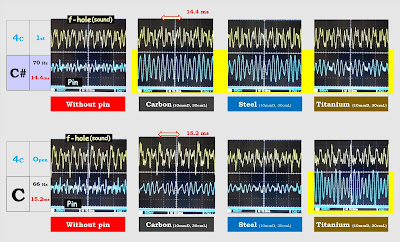60. Forty six chromatic notes of cello
[ 06/28/2018 ] Labels: 60.Sound color
Each chromatic notes around the wolf tone(around E) seemed to have its own waveform shapes.
Let's check up 46 chromatic notes of cello, from Cstring-C(66Hz,4C-0penC) to Astring-A(442Hz,1A-12thA).
This study will probably show us a very rough picture for (1)relation to the sound color of each chromatic notes, (2)resonant chance ratio of endpin on floor and (3)overall endpin-floor effects.
Adopted a 7-year-old cello, down bowing, compared with 3 endpins and 'without pin'.
20. Vibration of endpin tip on AEH
[ 06/23/2018 ] Labels: 0.Vibration-Video
Vibration of endpin tip on AEH-011.
32 times slower, C66Hz Pizzicato, 10mmD endpins(Steel pipe, Carbon, Titanium).
Advanced Endpin Holder improves resonance and response on cello by mitigating the effects from endpin and floor.
63. Memo for wolf tones
[ 06/17/2018 ] Labels: 63.Wolf tone
Data(1) to (4) show some exact extincting moment of wolf tones. Especially the intensity of wave looks almost die down briefly at data(1) to (3). Whereas spiral-like continuation was seen in data(4).
At this observation, wolf-tones occurred around at 6.0ms period(i.e. E tone). Many usual E cases, the waveforms show a pure form like a sine curve. If a new E note is bowed by a cello player, (and if the pitch is slightly shifted, and the sound is bulldozed), probably the top plate of cello has to be given up the current vibration(/frequency) and then succeeded to another newborn vibrations. It is like an unanimous society without opposing opinions. There should be no triggers to change the pace in their current inertial vibrations.
In data(1) and (2), at just the receding moment, we can find some new seeds for a new pitch.
The old tone(A) and the new tone(C) look slightly different in frequency.
The receding period(B) seems to be prolonged because it has to contain a transition time. As a result, player might also hear a grace note from D#, D, C# or thereabouts with sudden crescendo, it will be so annoying.
On the other hand, data(4) might suggest some hints to mitigate the wolf tone. Some bowing skills or wolf eliminators will help to avoid to make up a flawless E sine curve. Data(4) rather has a minor shift from original E frequency at the wolf point.
ウルフトーン(音が消滅する瞬間)をオシロスコープで見ると、ほぼ消滅した後に復活しているdata①~③と、消滅途中ですでに新たな再生が起きている場合(data④)がある。
観察したチェロの場合、ちょうどE音(周期=6.0ms)付近で表板が全体共振し、サイン曲線のようなシンプルな振動をしていることがわかる。もし奏者がこの周波数とわずかに異なったピッチで演奏すると、楽器は許容することができず、自らのピッチの振動を消滅させた後に後継の新ピッチの振動をスタートさせることになる。つまり、路線を修正可能なトリガーを持たない全会一致社会では、自らを消滅させることでしか新たな社会を生み出せない。これがフルフトーンの実像のようだ。
DATA①②では消滅する直前にあらたなピッチの種が生成されているのが観察される。この時旧音(A)と新音(C)でわずかに周波数が変化しているように見える。
この切り替わりの数周期(B)のみを見ると切り替わりの影響のため一時的に平均周期が長くなっていると見ることができる。奏者にとっては、ちょうど C#,D,D#などからの(しかもppまたは無音からの)気味悪い装飾音がかかったように感じるかもしれない。
観察データの中には、data④のように完全に音量が消滅する前に新たなE音が生み出される場合もある。演奏テクニックやウルフキラーなどにより何がしかのトリガーを利用しながら、(少しずらした位相を生成しつつ)ウルフを軽減できる可能性があることを示している。この④の場合、ピッチ変化は比較的に少ない。
20. Vibration of endpin (Carbon, Titanium)
[ 06/12/2018 ] Labels: 20.Vibration-Video
When the both ends of an endpin are fixed, the rod resonates with destined tones and the overtones.
A carbon 10mmD 32cmL endpin and titanium 10mmD 30cmL are also resonate with C(66Hz) mezzo forte pizzicato.
20. Vibration of endpin (mf pizz, 32 times slower)
[ 06/08/2018 ] Labels: 20.Vibration-Video
Endpin (particularly such as: steel pipe 10mmD, 35cmL below tail-pin, anchored on floor) resonates with C(66Hz) mezzo forte pizzicato. See 32 times slower video.
In this video, 125-tempo vibration --> 125 x 32 / 60 --> 66Hz(i.e. C fundamental vibration)
63. Wolf tone and D to G tones
[ 06/06/2018 ] Labels: 63.Wolf tone
Let's try to glance at the waveforms of D to G sound on G string(of cello) that played by down-bowing.
In accordance with shifting from D to G note, the period time shortens as 7 millisecond to 5, and waveforms also changes, and the number of vibration in the period also changes. However at around 166Hz(period=6ms, E note), waveform takes a simple sine-curve-like form, sometimes accompanied with wolves.
In many usual cases, top-plate's vibration(/fundamental vibration) shifts by giving way the role to another secondary vibration. But E vibration (..in this case/instrument..) cannot allow any other sub-fundamental nor any diversity chances. The old(/anachronistic) pitch seems to be died and hand over to the other newborn pitches(/vibration timing).
Some people may say it should be understood as 'interference and beat issue'. As long as we observe the oscilloscope data, the truth seems a little bit different from 'interference'. This phenomenon must be depending on the cello(/top-plate)'s structure and materials. We will focus on a 'sound disappearing moment' of the wolf tone later.
A steel pipe endpin(10mmD, 30 cmL under tail-pin) was adopted during this measurement, the endpin well resonated at D or D# and F or F# note.
CelloのG線上の D→G音の波形を並べた。この順で周期(基音-基音の時間)が約7ミリ秒→5ミリ秒と短くなる。
この1周期の間に多くの場合複数の振動(2次的な各音)を含んでいるが、その振動波形パターンも変化していく。
周期-6ms、166Hz(E音)付近で、複雑な波形はサイン曲線のようなシンプルな振動に代わり、同時にウルフトーンを発生させる。
E音(付近)以外では波形がシフト・変身しながら連続して音を生成できるのに対して、E音(付近)ではシフトすることができず、一旦自らを消滅させた後新たなトーンとして再出発している姿がみえてくる。この不連続がフルフトーンの正体のようだ。
干渉とうなりの話とは少し違っていそうだ。次回の投稿では、このウルフ部分をさらに拡大してみてみよう。
一方、この測定では、10mm径の30cm長さのスチールパイプエンドピンを使用して、ダウンボーイングで行ったが、特定の音(D-D#、f-F#)に対してエンドピンが共振する現象が見られた。













